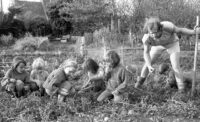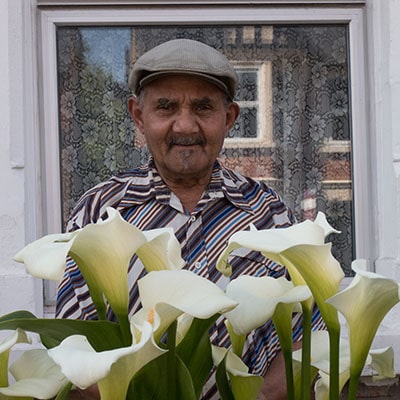Colin Ward and everyday anarchist solutions: allotments and other makeshift landscapes
Colin Ward was always drawn to the kinds of spaces where people could participate in what he referred to as the ‘anarchy of everyday life’. Not strictly ungovernable spaces, but contexts in which self-organising was at least tolerated and where activities that were messy or seen as odd could be enjoyed without being disturbed. These were often spaces colonised by children, outside the formality of playgrounds and the prying eyes of adults. But also those ‘makeshift landscapes’ to be found on the edges of towns and cities where railway lines and canals met abandoned quarries and gravel pits, landfill sites, scrap metal dealers breakers yards, and allotments.
Why was Ward so taken with these unplanned and largely unloved spaces? His intellectual journey was influenced by a number of anarchist and utopian writers, notably Peter Kropotkin, especially his books Mutual Aid (1902) and Fields, factories, and workshops of tomorrow (1899), which Ward re-edited and introduced to a contemporary audience in 1974, the philosopher Martin Buber, who set out in Paths in utopia (1949) the difference in the space between what the political power of state needed to be and what it often was, in the process squeezing out what he referred to as ‘social spontaneity’, and the writings of planners and educationalists Paul and Percival Goodman whose books Communitas (1947) and Growing up absurd (1960) articulated a view of childhood and the spaces children inhabited, which advocated a more informal learning environment for children and which was at odds with the rigidity and conformism of the educational system as they knew it.
Ward’s biographer Sophie Scott-Brown (1) sets out the social vision underpinning his anarchism in her Introduction, ‘For Colin Ward, anarchy was ordinary, everywhere and always in action. It happened on our city streets, allotments, around kitchen tables, in village halls, town squares and pub snugs.’ The decentralist and localist impulses, the advocacy of mutual aid, and the focus on human need are what she refers to as ‘an ethics of practice’, the anarchy of everyday life. This approach led to a world view that did not always sit easily with the anarchist and other countercultural trends that exploded around him from the 1960s onwards. As Scott-Brown puts it: ‘There were significant differences between his invocations of ‘everyday life’ as a sphere of meaningful political action and the ‘personal politics’ of for example feminist activists. Where he laid much stock in invoking ‘common sense’, the latter sought to challenge and disrupt the very notion of it […. ] His favourite characters, allotmenteers, art teachers or housing co-operativists, may have been on the fringes of society but they were not social outsiders; if anything they were quite the reverse.’ To Ward these were people who practiced the anarchy of everyday life and did so in spaces that they carved out themselves from a more conformist mainstream society. As a young man in his early writings in Freedom he celebrated the occupation of disused military camps by homeless families after the War as a form of instinctive mutual aid which he characterised as ‘the practicability of anarchism’ in the face of a serious shortage of housing. Over time this morphed into a fascination with the area between country and city where a wide range of spaces and settlements and newer forms habitation and livelihood transformed the landscape, what Raymod Williams referred to as ’border country’, and what has more recently come to be known as ‘edgelands’. Ward explored these spaces where he and fellow writers including Dennis Hardy and David Crouch found caravan sites, plotlands, camping grounds, smallholdings, allotments and children’s dens and hiding places.
The attraction was not just to these intermediate physical spaces in themselves, but also to the activities, or ’social space’ that Buber identified, and that they frequently engendered. It is this which Jeff Bishop and Paul Hoggett (2) analysed and celebrated, that of the unexplored world of the hobby or enthusiasm, of how people organise their joint activities in their spare time, and the vast myriad of everyday cultural and leisure activities and the clubs, groups, associations and federations created to sustain them. These activities are about communication, neighbourliness, sharing and mutual support, rather than competition, whether that be cricket clubs, model railway enthusiasts or ballroom dancing. While many like upholstery, snooker or drama, are physically quite bounded, many others such as canal or railway preservation, metal detecting or orienteering take advantage of the same intermediate physical spaces as well as enhancing that social space in their locality too. The further the authors delved into the subject the more they felt that they had stumbled ‘into an area of social life which was massive in its proportions, rich in detail and of fascinating complexity, but almost completely overlooked.’ For Ward this was an infectious delight in the ordinary; anarchy in action.
Ward’s interest in the land and its opportunities whether that was for squatting, self-build, or small-scale agriculture have lengthy antecedents. One of the many themed issues of Anarchy under his editorship between 1961-70 was one on ‘The Land’ (no 41, July 1964). The issue focuses mainly on agriculture and he wrote (under the pen name of John Ellerby) on the importance of small-scale agriculture and industrial production, reprising Kropotkin’s ideas in Fields factories and workshops (which indeed doubles as the title of his article). Kropotkin, way ahead of his time in many ways, emphasises that humans are an intrinsic part of nature – ecological sensibility – and that soils could be improved in terms of productivity by human activity as small-scale agriculturalists and allotmenteers well know. In this context he also emphasised the importance of intensive agriculture, horticulture, market gardening, intensive field cultivation, greenhouses and kitchen gardens. He prefigures the more recent concerns around organic growing, ‘human scale technology’, permaculture and community gardens, all of which Ward champions. One of Ward’s most insightful analysts is Stuart White (3) who connects his Town-Country ‘social vision’ through garden cities, housing coops, community gardens and allotments to small scale industrial production in community workshops, and the mutuality of Local Exchange Trading Schemes. While this can, with a little imagination, be seen as a vision of a possible future society, Ward is generally more concerned with what people can and do experience right now.
His interest in self-build movements in housing, he was a great admirer of Walter Segal’s methods and successes in south east London, was most fully articulated in his work with Dennis Hardy on ‘plotlands’ (4) where he traces their history starting at the end of the nineteenth century when working class people began to purchase land within a reasonable distance of cities such as London at depressed prices. The term ‘plotlands’ came about because when land was ’dirt cheap’ in the agricultural depression which lasted from the 1870s to 1939, it was parcelled up into ‘plots’ by speculators and sold off, often for £5 or less per plot. The purchasers built on the plots and in doing so new communities, most famously Peacehaven in Sussex and Jaywick Sands in Essex became established. They weren’t exactly loved by local planners or their neighbours, but rather seen as ‘bungaloid growth’ in a pristine landscape. As White puts it: ‘Many middle class observers viewed the developments at the time with alarm and disdain, and post war planning legislation was motivated in part by a desire to prevent them happening again. Ward however is deeply impressed by the episode. Where others see an unpleasant untidiness, even a ‘vast pastoral slum’, Ward sees a prime example of creative direct action by which working class people crawled out of the very real urban slums in which they lived and found for themselves a modest place in the sun.’ A ‘peopled landscape’ was what Ward called these places, somewhere that low income families ‘gained the freedom to move into a more spacious life that was taken for granted by their betters’. Ward describes the process (5) ‘Mr Fred Nichols of Bowers Green in Essex was in his seventies. He had a poverty-stricken childhood in East London and a hard and uncertain life as a casual dock worker. His plot 40ft wide and 100ft long cost him £10 in 1934. First he put up a tent which his family and friends used at weekends, and he gradually accumulated tools timber and glass which he brought to the site strapped to his back as he cycled the 25 miles from London. For water he sank a well in the garden. His house was called ‘Perseverance’.’ It reminds me of the ‘horticultural strips’ I came across outside Bidford on Avon when I was working for Warwickshire county council and responsible amongst other things, for their farms and smallholdings. These, eight in all, are an extraordinary remnant from the medieval strip farming systems, long, narrow and typically about 0.5 hectares each. A cross between an allotment and a smallholding they support a thriving community of part-time farmers who have developed an extensive system of sheds and barns where they engage in everything from motorcycle and farm machinery repair to large scale home brewing, as well as the small-scale commercial cultivation of their plots. Marion Shoard poetically refers to these kind of encampments as ‘self-seeded dreamscapes’. ‘Wildlife diversity here is often far greater than in the surrounding countryside and many of the structures are more fascinating than those of nearby towns and cities.’ (6). Heaven on earth for Ward.
Dreamscapes, self-seeded or not are what attracts many an allotment plot holder to their plot and what Ward and his fellow author David Crouch home in on in their book The allotment, its landscape and culture (1988). For them the allotment is a marginal but vital place where people of modest means can reclaim something of their own lives and where old patterns of mutual aid still flourish, where the ‘gift relationship’ is simply part of the fabric of life. What plot holder has never given away to neighbours lovingly tended veg in a time of glut, or gratefully accepted seedlings after their own were ravaged by slugs? The allotment is not just about food production but a cultural freedom that has thrived on official disregard and neglect. The image of the allotment as tatty old eyesore is correct, if that is what the viewer wants to see, but Ward and Crouch insist that it be granted the dignity of its own unique if accidental aesthetic. Man y a photographer over the past thirty years has come to the same conclusion, with moving and insightful results. This is a peopled landscape undesigned, diverse and rooted in a history which seems to run back over five hundred years, as the Bidford plot holders attest to. Ward and Crouch celebrate the immigrant in the tapestry of allotment history, men such as Sebastien Espada the anarchist refugee from the Spanish Civil War who in the 1940s used his training in horticulture to grow peppers, aubergines, and even Kentucky tobacco on his plot in Ealing, until the Excise Man came calling. That tradition of immigration driving innovation, learning, and reform on allotment sites continues to this day. The Chair of my own site is a young Palestinian woman, while other plot holders are Kurdish, Algerian, Chinese, American, Serbian and Polish. An Iranian refugee currently housed on the Bibby Stockholm barge visits a British family and is to be found helping with the pruning, mowing, and weeding on their plot. Trained as a carpenter in a previous life, he has constructed a series of raised beds on their plot that are the glory of the site. The nature and composition of the working class that Ward and Crouch refer to has changed in the nearly forty years since they wrote The Allotment, but the allotment still represents, for them and us a particularly vital landscape. As they put it: ‘..a working class landscape, a productive landscape, conforming to no ‘style’ … found in conditions of need and poverty… it is an intensive and inventive landscape, free from everyday outside controls and forced by necessity towards initiative and invention.’
y a photographer over the past thirty years has come to the same conclusion, with moving and insightful results. This is a peopled landscape undesigned, diverse and rooted in a history which seems to run back over five hundred years, as the Bidford plot holders attest to. Ward and Crouch celebrate the immigrant in the tapestry of allotment history, men such as Sebastien Espada the anarchist refugee from the Spanish Civil War who in the 1940s used his training in horticulture to grow peppers, aubergines, and even Kentucky tobacco on his plot in Ealing, until the Excise Man came calling. That tradition of immigration driving innovation, learning, and reform on allotment sites continues to this day. The Chair of my own site is a young Palestinian woman, while other plot holders are Kurdish, Algerian, Chinese, American, Serbian and Polish. An Iranian refugee currently housed on the Bibby Stockholm barge visits a British family and is to be found helping with the pruning, mowing, and weeding on their plot. Trained as a carpenter in a previous life, he has constructed a series of raised beds on their plot that are the glory of the site. The nature and composition of the working class that Ward and Crouch refer to has changed in the nearly forty years since they wrote The Allotment, but the allotment still represents, for them and us a particularly vital landscape. As they put it: ‘..a working class landscape, a productive landscape, conforming to no ‘style’ … found in conditions of need and poverty… it is an intensive and inventive landscape, free from everyday outside controls and forced by necessity towards initiative and invention.’
In a sense this is what Ward recorded in Cotters and squatters (2002), marginalised groups setting about creating their own futures under the noses of authority. He describes the ‘free miners’ in the Forest of Dean who in the nineteenth century existed as ‘a community of small proprietors [with] a considerable degree of independence and freedom from authority’, and the history of popular squatting in Royal forests, something refugees were reported to be doing in the New Forest in 2023, and more extensively in the Calais ‘jungle’ at Sangatte as they attempt to reach the UK; ‘people’s history’ being played out in real time.
In my experience, allotments these days rather than being the preserve of the stereotypical male, the old man cycling home with a bunch of carrots over the handlebars, are as much or more for children, especially as families, perhaps reinterpreting the aspiration of Harry Thorpe’s advocacy of allotments as ‘leisure gardens’ in the 1960s, are to be found ensconced on their plot appreciating the sunshine and birdsong, while their children are making mud pies, chasing pigeons, finding little spaces of their own between the hedge and their parents shed, gleaning harvest leftovers, or helping with the barbeque on a weekend evening as friends join them for music, beer and song at the end of a long day. For children allotments are a safe space, and a recurring theme in Ward’s The Child in the City (1978) is children’s creative appropriation of city spaces. Ward contrasts American playgrounds ‘designed for insurance companies’ with what he argues all urban children should have access to, ‘gardens where they can keep their pets, and enjoy their hobbies, and perhaps watch their fathers working with real tools; secret places where they can create their own worlds; the shadow and mystery that lend enchantment to play.’
In a way allotments can be described as quintessential Ward. Scott-Brown quotes Ward as saying ‘I am not a utopian anarchist – I look for day to day anarchist solutions.’ and she goes on to say ‘If the utopian pursued anarchism as an entire social design the latter [Ward] took it as a multipurpose gadget for loosening the restraints of everyday life. As a propagandist, he championed the designs, but by personal and intellectual convictions he was a gadget man, presenting ideas as resources to be picked over for the bits that could be used in the present.’ Ward himself in his book Influences (1991) in summing up why Martin Buber was so important to him said, ‘Buber’s exploration of the paths to utopia, far from confirming an acceptance of the way things are, confirms, [….] that the fact that there is no route map to utopia does not mean that there are no routes to more accessible destinations.’ What Ward found on allotments and similar places of escape or play were those ‘accessible destinations’ for an anarchist, right in our midst.
References:
1. Sophie Scott-Brown: Colin Ward and the art of everyday anarchy. Routledge 2023
2. Jeff Bishop and Paul Hoggett: Organising around enthusiasms; mutual aid in leisure. Comedia 1986
3. Stuart White: Social anarchism, lifestyle anarchism and the anarchism of Colin Ward. Anarchist Studies Vol 18 no 2 2011. pp 92-104
4. Dennis Hardy and Colin Ward: Arcadia for all: The legacy of a makeshift landscape. Mansell 1984
5. Colin Ward: A peopled landscape, in Richer futures fashioning a new politics ed Ken Worpole Earthscan 1999.
6. Marion Shoard: ‘The age-old appeal of living life on the edge’. Observer 6 March 2011.
This article first appeared in the July/August 2024 special issue of Town & Country Planning to mark the 100th anniversary of Colin Ward’s birth.

